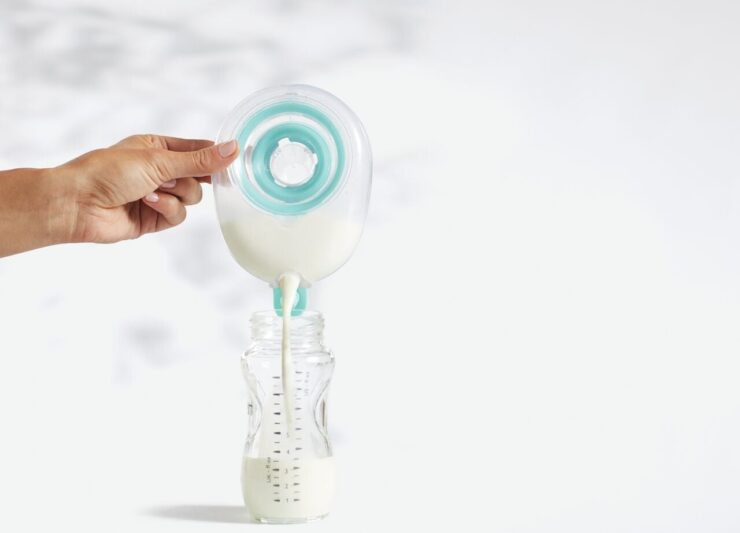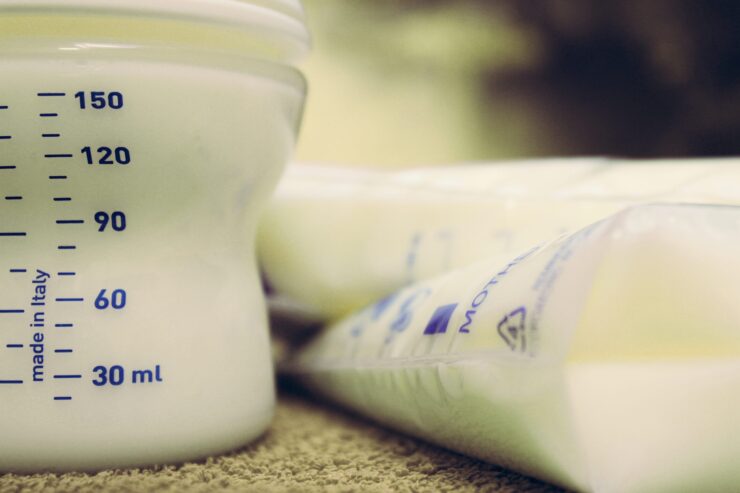The first thing to remember when thinking, “how much milk should I be pumping?” is that breast pumps can help you express milk, but can never be as an effective nursing baby in the release of milk.
This means that the volume of milk that a baby typically obtains from nursing at your breast is going to be far greater than those obtainable from a breast pump.
After understanding this diversity, then it’s easier to understand how much milk you can relatively pump.
If you are pumping full-time, you can pump as much as 2 ounces for both breast/pumping sessions. While you can try to pump more, this is what most mothers will be able to produce.
Also, the amount you pump in each session and day to day may be different. So, if you already have a quota you like to meet each day/session, you shouldn’t be surprised if you surpass that or don’t meet it.
This further supports the notion that the milk available to your baby when he/she nurses directly may be significantly more.
Before going into great detail about how much you can expect to pump (on average), let’s look at certain things that may affect the amount you can pump.
Factors Affecting the Amount of Milk You Can Pump

Here are a few things you should watch out for:
1. Type of pump
The first thing to consider is the type of pump you are using. You have to first ensure you’re using the appropriate pump for your purposes.
If your pump is older, it may not be performing optimally. Also, an electric pump is going to be much more effective at helping you express milk than a manual breast pump.
Aside from that, it’s a lot easier to use and control. For that reason, you should look at the equipment you’re going to be using since it’ll affect your production levels.
2. Parts of the pump
Another possible factor is the parts of the pump. Some parts may need replacement or just not function as required. If you’ve been using some of the parts for a year, for instance, some of them may have lost their power.
As a result, may not perform well. You want to look at these and if possible replace any worn out part.
3. Consistency
Your milk supply may reduce if you stop expressing milk for several days. Pumping and expressing milk consistently ensures that you are able to produce milk at the same rate.
However, that may decrease the milk supply once you slow down. For greater milk supply, you should definitely do more nursing or pumping.
What You Should Know About Increasing Your Pumping Output
One of the things you can do is to increase the frequency at which you pump.
Try to nurse whenever you are with your baby. If possible, you should also increase your pumping frequency so as to get a better flow.
Another technique to increase your milk supply is to add an additional 10/15 minutes time to your pumping sessions.
Doing that is going to help you pump the optimum amount of milk.
Always start with breast massage and breast compression before any session.
This will help the milk flow earlier and relax/calm the nerves so you can get a greater supply.
Now, you know what may hinder breast pump output and how you can possibly increase it. Here is how much you can produce in each stage of your baby’s growth.
During the First Days of Life
The amount of milk an individual should be pumping is great to be known and the answer to it is different from one mom to the other.
There are biological standards that are in place to understand the quantity of milk that a particular woman can produce.
A newborn’s stomach in the first few days can typically hold an amount not exceeding one ounce at a time.
This amount will rise to two ounces by the end of a week of life.
This is actually the reason newborns nurse more often. A woman’s milk is the perfect nutrition for babies as it is easily digestible.
During the first time, pumping can provide a small quantity of colostrum and this remains until one’s milk comes by.
The only way that is used for milk to come in is simply stimulating the breast to produce milk. What does this mean?
It means it is great to pump regularly the same way a baby does to establish the need of the body for sufficient milk supply.
Amount When Your Baby Is a Month Old
The amount of milk a baby’s stomach holds rises to between three to five ounces once the baby is a month old. As you can see, by calculations this is about twenty-five ounces in a single day for most babies.
To cover up the newborn’s milk supply needs in a single day, a woman would ideally need to pump enough milk to cater to this.
But then, a woman with some help can pump more milk to be considered as a backup if there occurs a chance of a spill or at sometimes extended absence when pumping.
Milk Production Up to the Age of Six Months

Milk production after a period of a month should level off until your newborn attains the age of six months. At this age, most babies will start practicing eating other foods and the need for milk starts to go down slowly.
But then, experts in the field say that the introduction of solid foods to kids after this age should be for fun and moms are encouraged to breastfeed their newborns until they attain an age of a year.
So, throughout this age, breast milk should be the primary source of a baby’s nutrition needs.
The Right Time to Pump Milk
Most moms are said to pump more milk in the morning hours when starting off the day. This is actually the reason you will notice varying milk production amounts over the rest of the day.
To have the amount of milk that is required, babies normally respond to this by demanding or rather breastfeeding at an increased rate when the production is slower at the later hours of the day.
The best time to pump enough is immediately the thirty and sixty minutes after you have completed the first morning nursing.
This is the time you will pump up more milk than any other time for the rest of the day.
It is ultimately right to measure up your kid’s milk needs against your milk production rather than considering the averaging amounts that have been stated on different researches for women everywhere.
How Much Should I Be Pumping
From the foregoing, answering the question, “how much should I be pumping” isn’t straightforward. This is because of the amount of milk you should produce may be dependent on the sex of your baby and the level of production.
Some research studies confirmed that boys tend to demand more milk than girls.
Again, some studies have established that milk production in the early stage of breastfeeding will below. But will gradually increase throughout the infancy from the first month up to eleven months of age.
When looking at how much milk should you produce when pumping, you have to put all these things together.
First, consider the sex of your baby. Second, measure the amount you’re able to produce, especially during the first month.
Once you are able to do this, your insight will be greater about how much milk you should pump.
References
1. Kent, J. C, How breastfeeding works. J Midwifery Women’s Health, 52(6), 564-570, 2007
2. Mohrbacher, N, The magic number and long-term milk production, Clinical Lactation, 2(1), 15-18, 2011
3. Butte, N.F., Lopez-Alarcon, & Garza, C., Nutrient Adequacy of Exclusive Breastfeeding for the Term Infant During the First Six Months of Life (PDF), Geneva, Switzerland, World Health Organization, 2002

